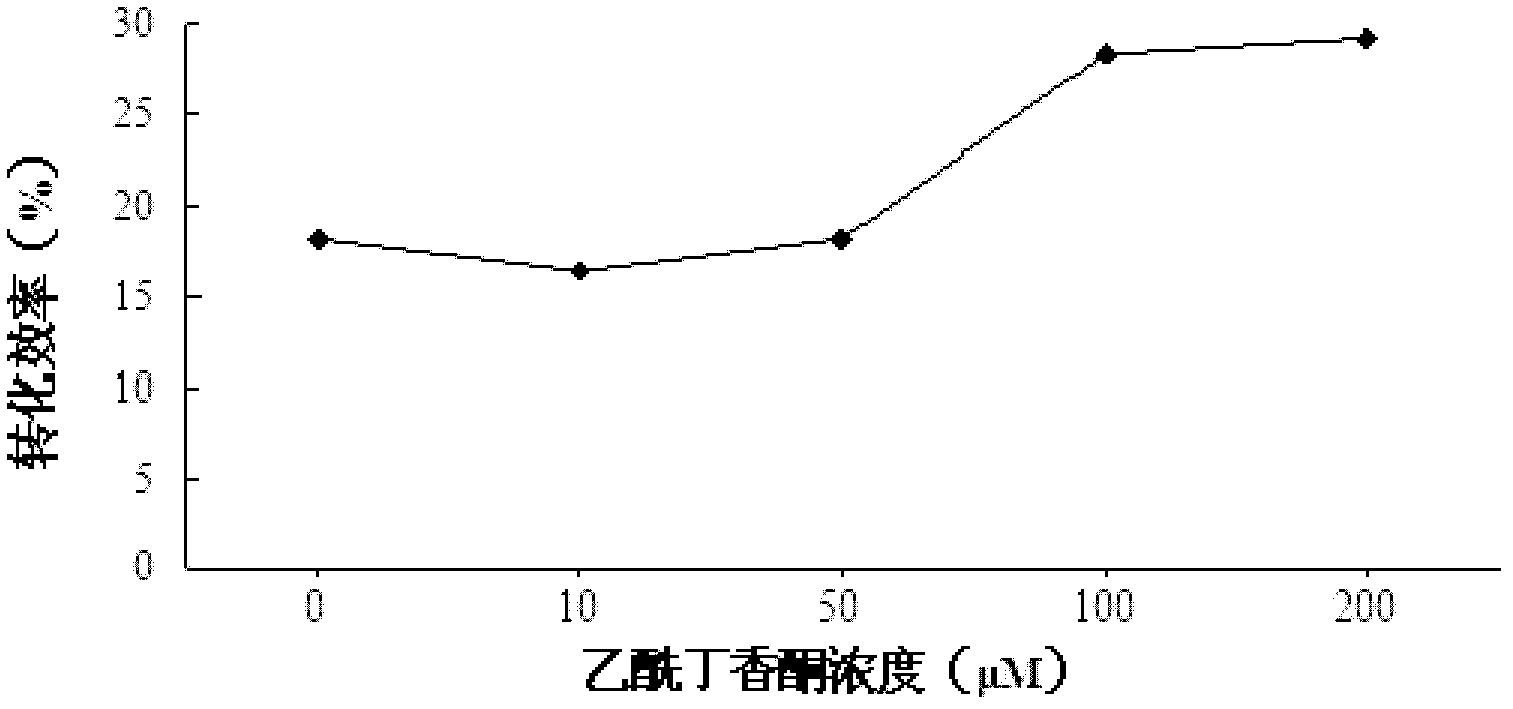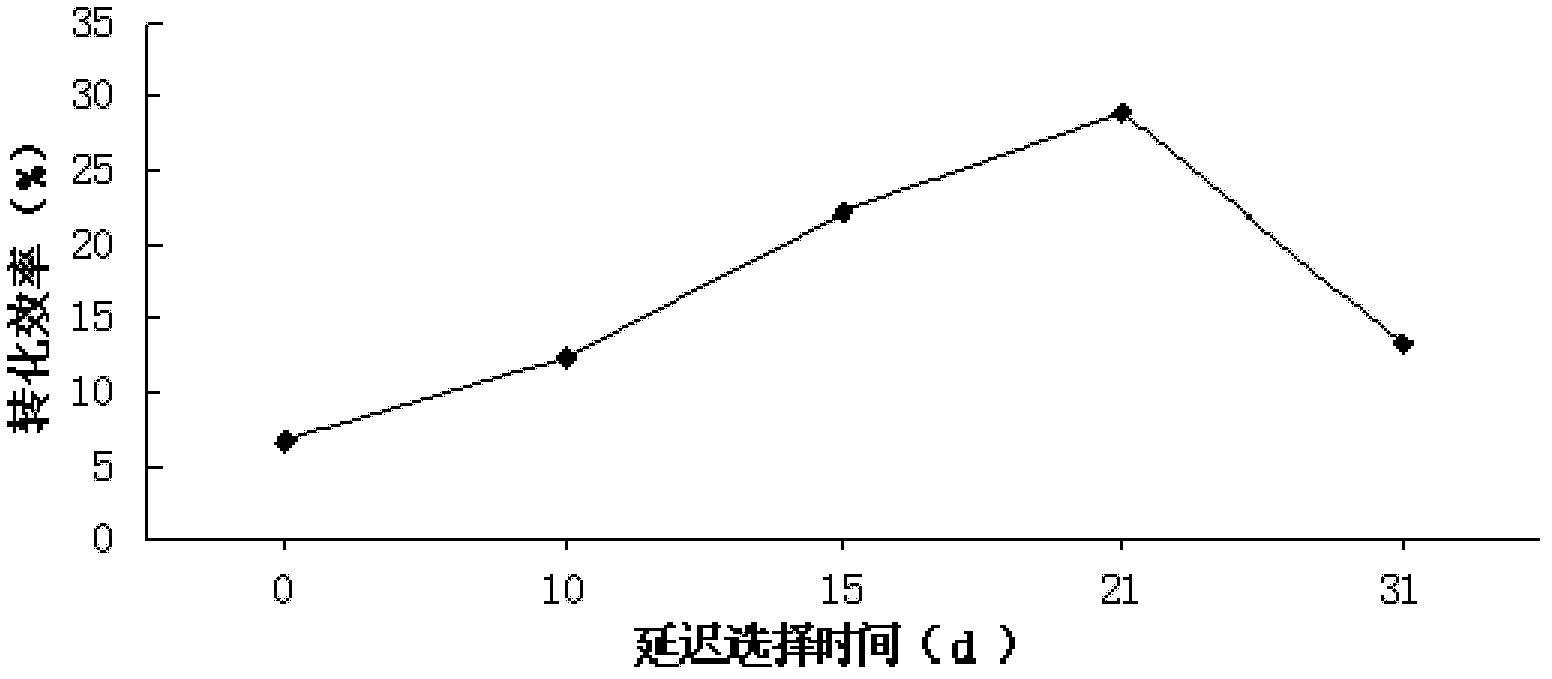Agrobacterium tumefaciens gene transformation method of hybrid poplar
A technology of gene transformation and Agrobacterium, applied in the field of genetic engineering, can solve the problems of relatively little research on Baiyangpai and its hybrid clones, and the inapplicability of Baiyangpai, achieving the effect of short cycle time and high transformation efficiency
- Summary
- Abstract
- Description
- Claims
- Application Information
AI Technical Summary
Problems solved by technology
Method used
Image
Examples
Embodiment 1
[0044] An agrobacterium gene transformation method for hybrid poplar, comprising the steps of:
[0045] (1) Pre-cultivation:
[0046] The axillary buds of 717 poplar (P.tremula×P.alba) were subcultured on the basic medium, and cultured for 4 weeks to obtain tissue cultured seedlings; cut off the 0.8-1.5 cm stem section without axillary buds of the tissue cultured seedlings, and cut along the The wounds were drawn twice in the direction of the longitudinal axis of the stem section, placed in M1' medium, and pre-cultured at 24°C for 2 days in the dark;
[0047] (2) Activation and cultivation of bacteria:
[0048] Pick up Agrobacterium C58 / pMP90 / pH7GWIWG2(I) stored at -80°C with a pipette tip onto the YEB solid medium containing rifampicin, gentamicin and spectinomycin, and incubate in the dark at 27°C for 20 hours ;Pick the cultured Agrobacterium to streak on another YEB solid medium containing the same antibiotic as before, and culture it upside down at 27°C for 48h in the da...
Embodiment 2
[0073] An agrobacterium gene transformation method for hybrid poplar, comprising the steps of:
[0074] (1) Pre-cultivation:
[0075] Place the terminal buds of 717 poplar (P.tremula×P.alba) on the basic medium for subculture, and cultivate them for 5 weeks to obtain tissue cultured seedlings; 2 The petioles of the leaves were placed in the M1' medium and pre-cultured for 3 days at 26°C in the dark;
[0076] (2) Activation and cultivation of bacteria:
[0077] Use a pipette tip to pick up Agrobacterium C58 / pMP90 / pH7GWIWG2(I) stored at -80°C on YEB solid medium containing rifampicin, gentamicin and spectinomycin, and culture in the dark at 28°C for 24 hours ;Pick the cultured Agrobacterium and streak it on another YEB solid medium containing the same antibiotic as before, and culture it upside down at 28°C for 40h in the dark;
[0078] Pick a single colony into a sterile test tube containing 3mL of YEB liquid medium containing the same antibiotic as before, and incubate in t...
Embodiment 3
[0102] An agrobacterium gene transformation method for hybrid poplar, comprising the steps of:
[0103] (1) Pre-cultivation:
[0104] The axillary buds of 717 poplar (P.tremula×P.alba) were subcultured on the basic medium, and cultured for 6 weeks to obtain tissue cultured seedlings; the 0.8-1.5 cm stem section without axillary buds of the tissue cultured seedlings was cut, and used The razor blade was drawn 3 times along the longitudinal axis of the stem section to cause wounds, placed in M1' medium, and pre-cultured for 3 days under dark conditions at 25°C;
[0105] (2) Activation and cultivation of bacteria:
[0106] Use a pipette tip to pick Agrobacterium C58 / pMP90 / pH7GWIWG2(I) stored at -80°C on YEB solid medium containing rifampicin, gentamicin and spectinomycin, and incubate in the dark at 29°C for 28 hours ; Pick the cultured Agrobacterium and streak it on another YEB solid medium containing the same antibiotic as before, and culture it in the dark at 29°C for 36 hou...
PUM
 Login to View More
Login to View More Abstract
Description
Claims
Application Information
 Login to View More
Login to View More - R&D
- Intellectual Property
- Life Sciences
- Materials
- Tech Scout
- Unparalleled Data Quality
- Higher Quality Content
- 60% Fewer Hallucinations
Browse by: Latest US Patents, China's latest patents, Technical Efficacy Thesaurus, Application Domain, Technology Topic, Popular Technical Reports.
© 2025 PatSnap. All rights reserved.Legal|Privacy policy|Modern Slavery Act Transparency Statement|Sitemap|About US| Contact US: help@patsnap.com



